Flat Tire Safety: What Every Driver Should Know
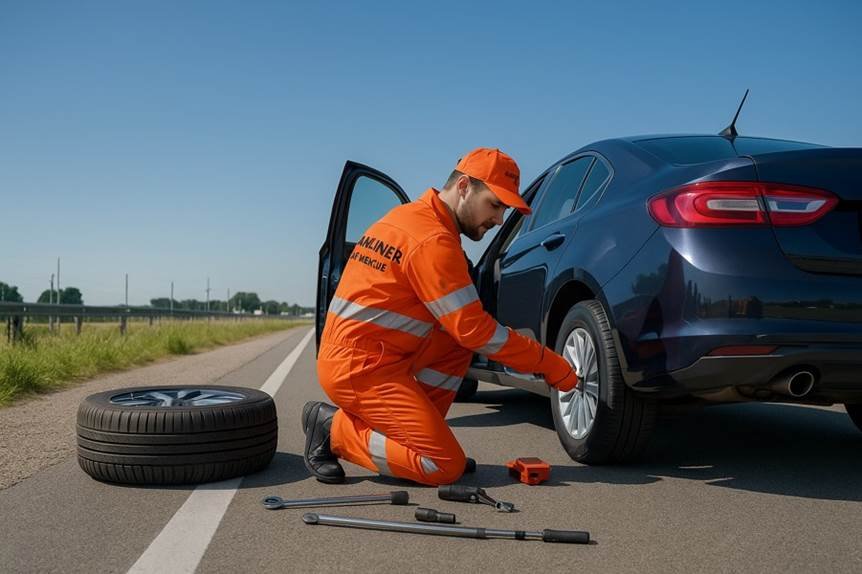
Getting a flat tire can turn a regular day into a stressful emergency, especially if you’re unprepared. This guide helps every driver—from new license holders to seasoned road warriors—handle flat-tire situations safely and confidently.
At-a-Glance: First 60 Seconds
- Stay calm and keep a firm two-hand grip on the wheel.
- Ease off the accelerator. Don’t brake hard or swerve.
- Signal and steer toward a safe spot away from traffic.
- Turn on hazard lights as soon as it’s safe.
- Stop on flat, stable ground (avoid curves, bridges, and soft shoulders).
- Assess surroundings before deciding on DIY vs. calling for help.
How to React Safely When You Get a Flat Tire
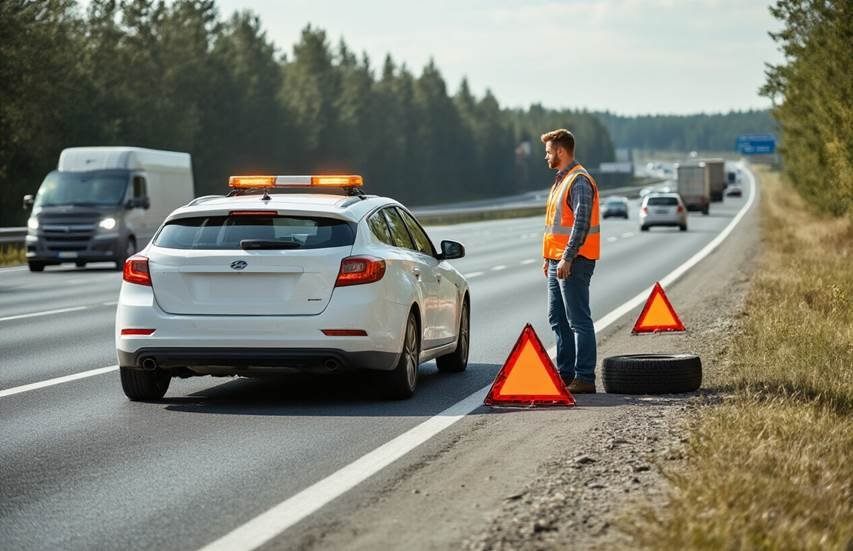
1) Stay calm and control your vehicle
- Keep both hands on the wheel; the car may pull toward the flat.
- Lift off the gas and let the vehicle coast; avoid sudden braking or sharp steering.
- Guide the vehicle smoothly toward a safe stopping area.
2) Pull over to the safest possible location
Use the options below as a quick guide:
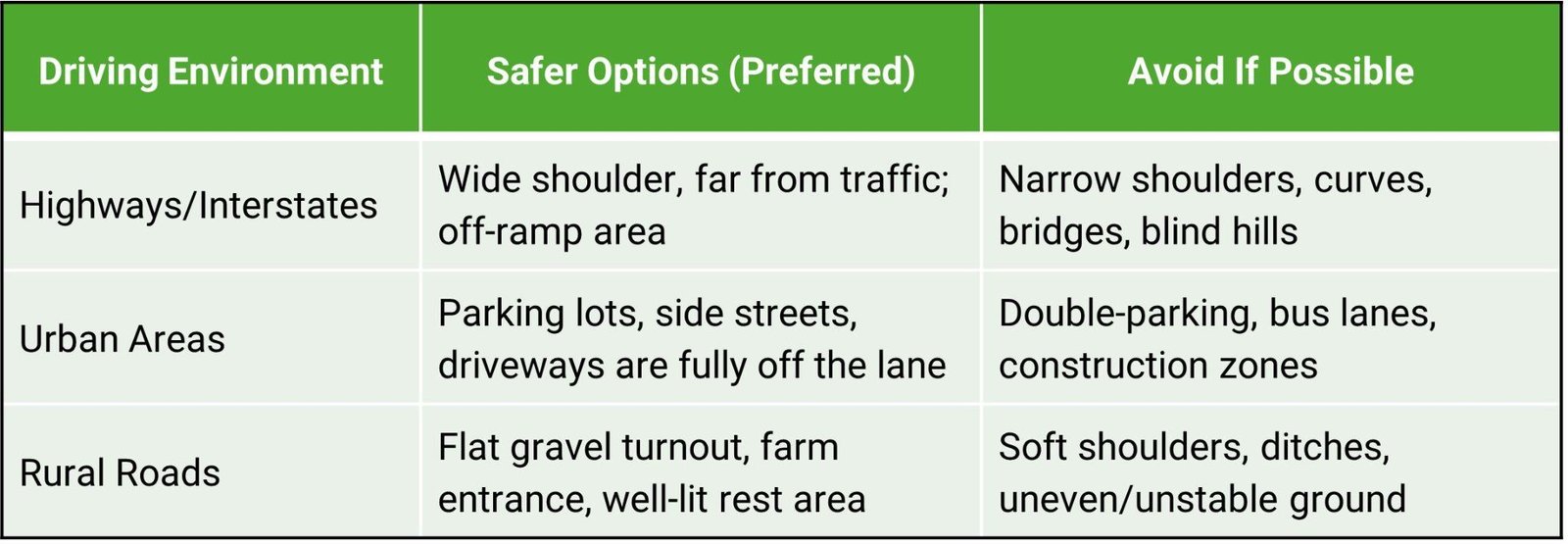
3) Turn on hazard lights immediately
- Improves visibility for other drivers in low light, rain, fog, or snow.
- Critical if you’re partially in a lane or on a narrow shoulder.
4) Assess your surroundings before taking action
- Consider traffic speed, space, lighting, weather, ground stability, and your comfort/experience.
- If conditions are unsafe or you’re unsure, wait for professional help.
Essential Tools and Equipment for Flat Tire Emergencies

Now that we have covered the immediate safety response to flat tire situations, let’s examine the critical tools and equipment every driver should maintain in their vehicle for flat tire emergencies.
Must-Have Kit (keep in the vehicle)
- Spare tire (properly inflated)
- Car jack rated for your vehicle
- Lug wrench sized for your lug nuts
- Wheel chocks/wedges (prevent rolling)
- Work gloves
- Tire repair kit (plugs, rubber cement, insertion tool) for minor punctures
Be Seen: Visibility & Safety Gear
- Reflective triangles (set 10 m / 30 ft and 30 m / 100 ft behind the car)
- LED flares or road flares (where safe/legal)
- High-visibility vest
- Flashlight (or headlamp)
Storage & Maintenance Checklist
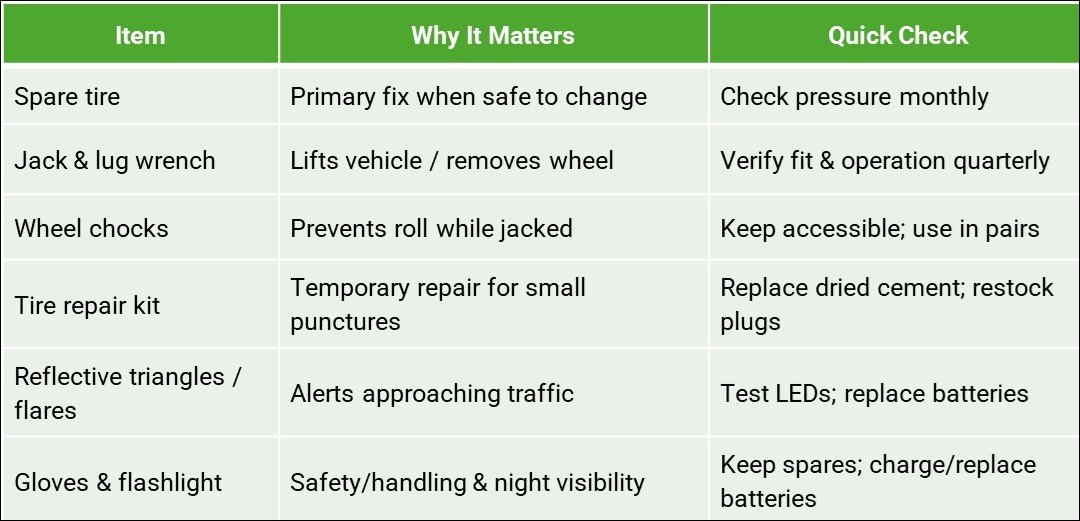
When to Change Your Tire Yourself vs. Call for Help
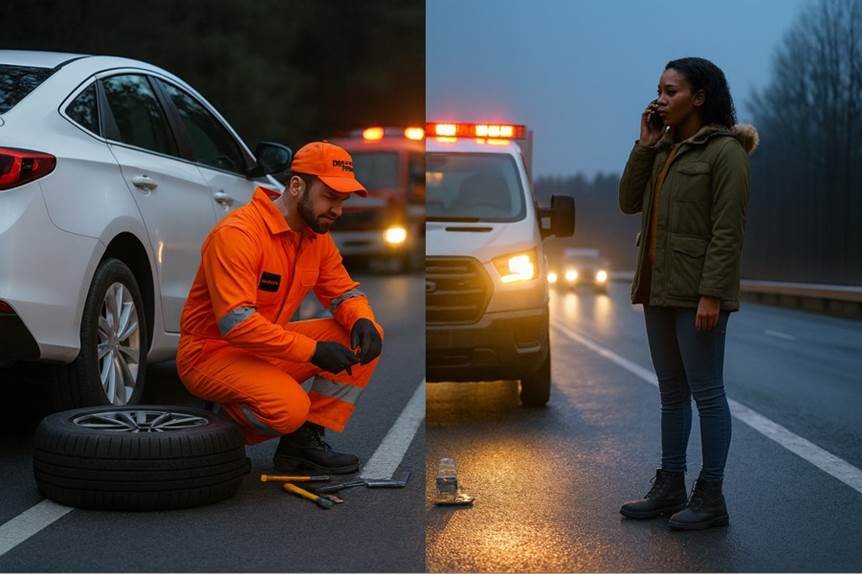
Now that we’ve covered the essential tools and equipment needed for flat tire emergencies, it’s crucial to understand when attempting a DIY tire change is safe versus when professional help is necessary. Flat tire safety depends heavily on your location, traffic conditions, and personal comfort level with the task.
Situations Where Self-Repair Is Not Safe
- Busy highways or high-speed traffic
- Narrow shoulders with little workspace
- Poor visibility (nighttime, heavy rain/fog/snow)
- Unstable ground or steep slopes
- Insufficient tools or you feel unsure/uncomfortable
|
Many regions have “Move Over” or slow-down laws to protect people at the roadside—but never rely on others to see you. If exposure to traffic is high, call a pro. |
|---|
Situations Where DIY Can Be Acceptable
- You’re well off the traffic lane with plenty of space.
- Good lighting and stable, flat ground.
- You have the right tools, know the steps, and feel confident.
Decision Matrix
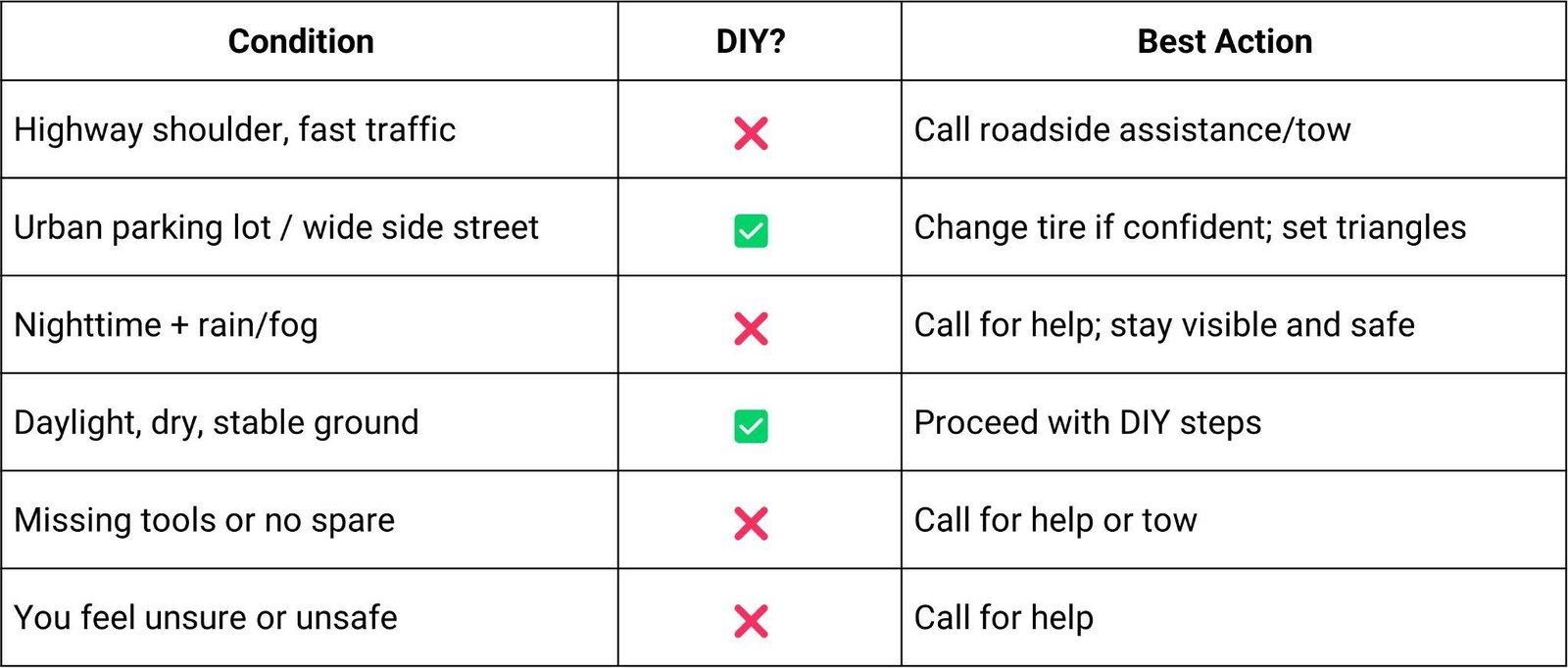
Alternative Options When You Can’t Change the Tire
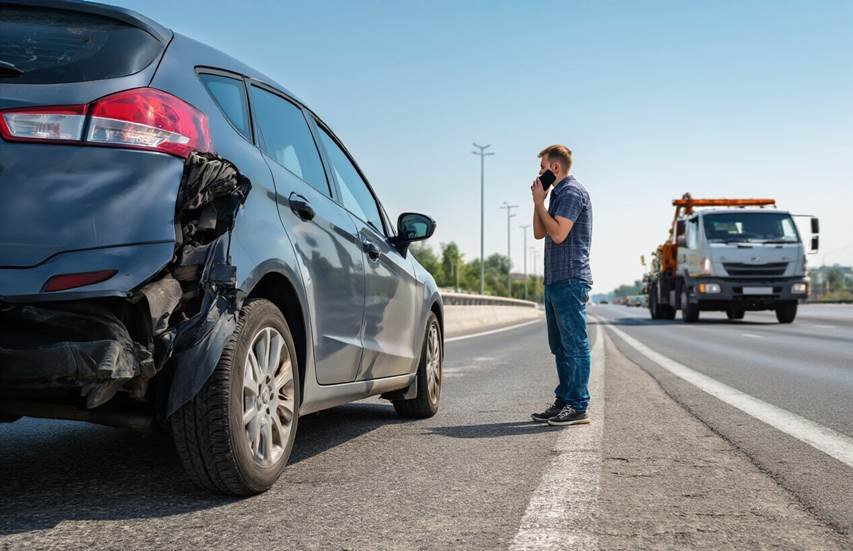
Now that we’ve covered the decision-making process for tire changes, let’s explore your options when changing the tire yourself isn’t feasible or safe.
When to Call a Tow Truck or Roadside Assistance
- High-speed roads, limited space, bad weather, or poor visibility.
- You don’t have a spare, the tire is shredded, or wheel damage is visible.
- You’re uncomfortable performing the change.
Benefits of Roadside Assistance Programs
- Professionals come to you with the right tools.
- Faster, safer resolution—no need to visit a shop immediately.
- Peace of mind in stressful conditions.
If You’re Outside Cell Service
- Use your emergency kit and triangles to stay safe and visible.
- If trained and conditions allow, perform a temporary repair to reach service.
- Let a trusted contact know your planned route before trips in remote areas.
|
Need Help Now? Call Dreamliner Road Rescue at (204) 963-8913 — 24/7 tire repair, replacement, and towing. We’ll get you safely back on the road. |
|---|
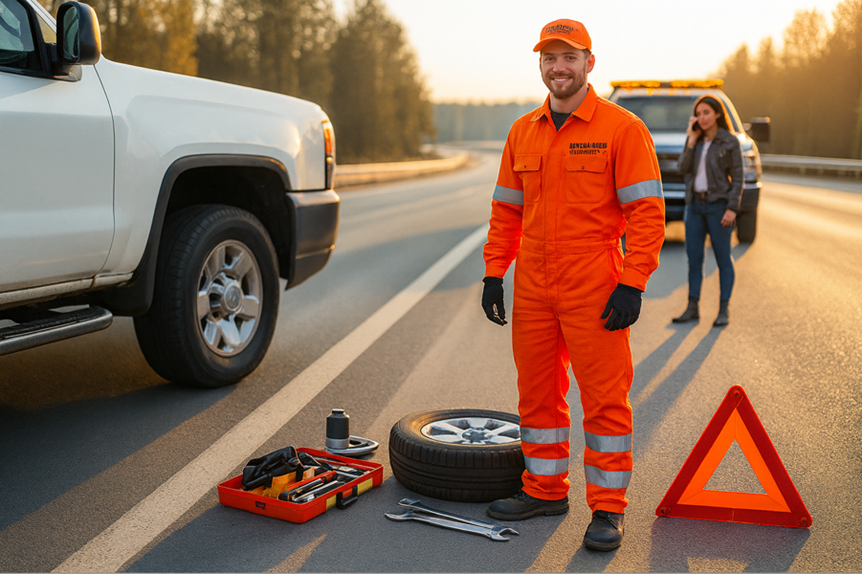
Conclusion
Knowing how to handle a flat tire can turn a potential crisis into a manageable pit stop. Prioritize safety over convenience: pull over to a secure location, turn on hazard lights, and assess conditions before acting. Keep your emergency kit stocked (spare, jack, lug wrench, chocks, repair kit, visibility gear) and maintain it regularly. If conditions are risky – or you’re unsure – call for professional help. With preparation and the right decisions, you’ll handle flat-tire emergencies confidently and safely.


